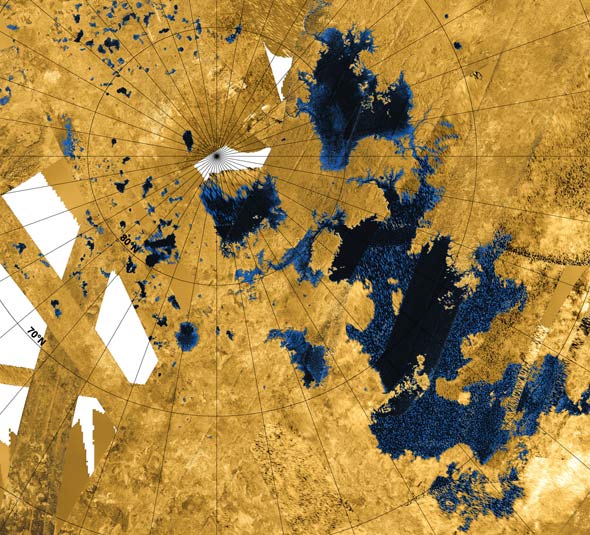Create a free profile to get unlimited access to exclusive videos, sweepstakes, and more!
Fly Over Titan’s Lakes of Liquid Natural Gas

Titan is Saturn’s largest moon and practically planet-sized itself. It has a thick atmosphere—the surface pressure is twice what it is here on Earth—made of frigid nitrogen with a dash of methane and hydrogen thrown in for fun.
And on the surface there are lakes of nearly pure liquid methane bigger than any of the Great Lakes.
The picture above is part of a huge mosaic of Titan’s north polar region created using the Cassini spacecraft’s radar imaging capabilities, and it is the most complete and detailed map of the area made yet. The images are made using reflectivity data from the radar—Cassini sends pulses of microwave energy down to the surface, and the strength and timing of the signal reflected back yields surface elevation, as well as giving clues about the composition of the surface.
This data comprises a three-dimensional map of the surface, so of course it was used to create a pretty cool fly-over animation. Pull on your warm jammies; this is a cold flight:
Titan’s lakes are pretty strange. For one thing, they’re incredibly smooth; the radar reflections show they’re flat to within a few millimeters. Also, Ligeia Mare (the lake at the very top of the image above) is almost completely transparent to radar—it must be very nearly pure liquid methane. Since they could “see” right down to the bottom, this allowed scientists to figure out its depth: about 170 meters (560 feet). Since it’s 500 kilometers (300 miles) across, it’s actually very shallow relative to its size.
Which brings up a point: All the liquid methane on Titan seems to be in this confined region; only a few percent of it exists outside this area. The new map hints that the geology is to blame: These regions are the right topography to collect and retain the liquid hydrocarbons. I suspect weather is involved as well. We know Titan has extensive dune fields across its equator, but the lakes are so smooth there must be very little wind in the north (at least, during the particular season on Titan when the observations were made).
But think on that. We’re talking geological formations, wind, weather, lakes, even precipitation! Titan is not just some point of light in the sky or some distant imagined place: It’s a world, with all the varied complexity and personality that implies. Think about how traveling on Earth changes what you see, from tall mountains to low-lying lakes, from wind-swept plains to rocky desert. Titan has all that and more.
But Earth-like it isn’t. I mean, seriously: On Earth, the Cuyahoga River in Ohio has caught fire due to fossil fuel pollution. On Titan, that’s what entire lakes are made of.
The Universe is weird. I wouldn’t have it any other way.


























